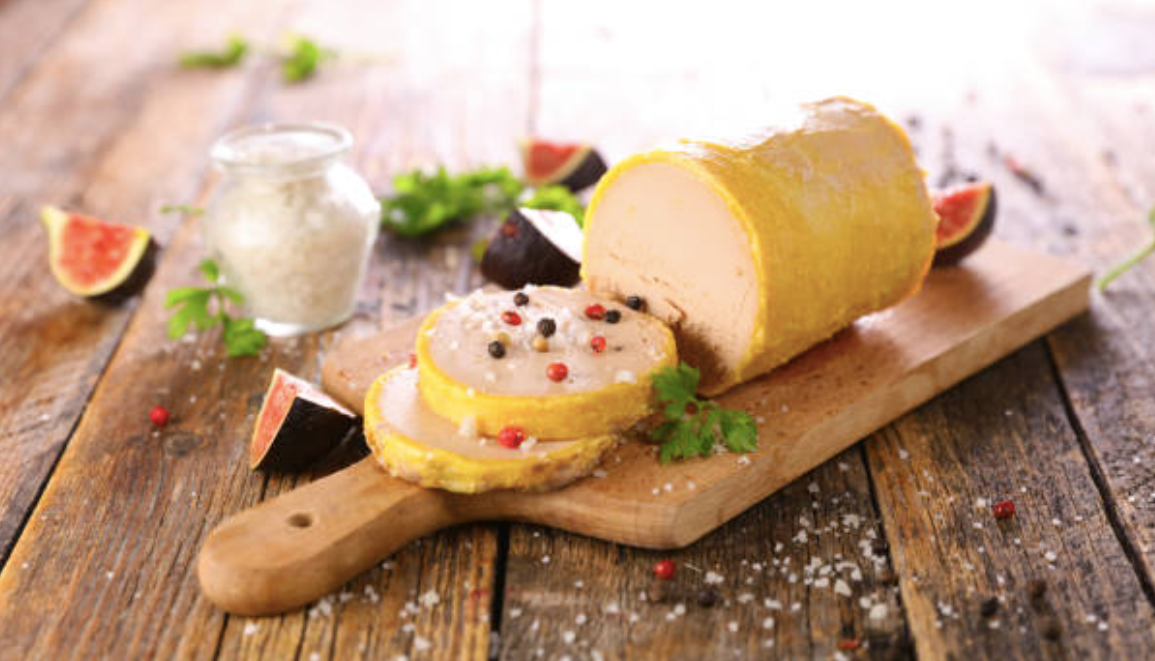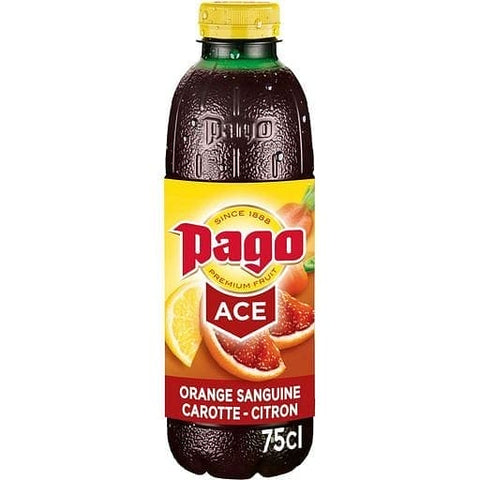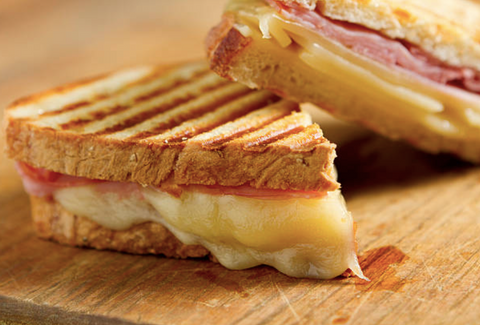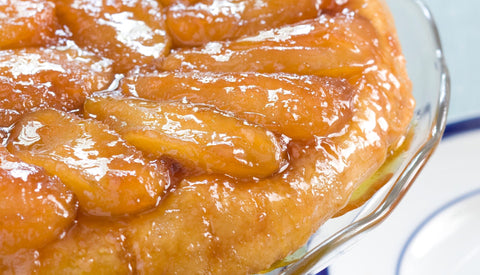Foie gras is a French term that means "fatty liver." It is made from the livers of ducks or geese that have been fattened by force-feeding them corn through a tube inserted down their throats. This cruel and unnatural practice, called gavage, causes the birds' livers to swell up to 10 times their normal size.
Foie gras production occurs in two stages;
- In the first stage, workers insert tubes into the birds' throats and pump up to 2 pounds of food into their stomachs two or three times a day.
- In the second stage, the birds are slaughtered, and their diseased livers are removed for sale as foie gras.
In a typical foie gras factory farm, ducks are crowded together in dimly lit sheds and forced to live amid the overwhelming stench of ammonia fumes produced by their waste. The birds have little room to move around—often less space than a standard sheet of paper per bird—and they spend most of their time standing on top of one another.
Foie gras is a popular and well-known delicacy in French cuisine;
- Its flavor is rich, buttery, and delicate, unlike an ordinary duck or goose liver.
- Foie gras is sold whole or is prepared into mousse, parfait, or pâté (terrine de foie gras) and may also be served as an accompaniment to another food item, such as steak.
- French law states that "Foie gras belongs to France's protected cultural and gastronomical heritage."
Production of Foie Gras
Foie gras — French for "fatty liver" — is a rich and luxurious food product made of the livers of ducks or geese. The two main production methods are;
- Gavage, in which the birds are force-fed by a tube to enlarge their livers before slaughter, and the natural method, where the birds gorge themselves on fatty feed for a period before slaughter.
Production of foie gras dates back thousands of years, but today it is most widely produced in France and Hungary. France dominates globally, with Hungary coming second and China third in terms of production volume.
- The most common preparation method is to force-feed the animals with a metal pipe attached to a funnel placed into the animal's stomach. The more force used, the fatter it gets. This results in some of the fattest duck livers in the world.
- Another method uses a tube, a carbon dioxide tank, and a plastic bag filled with ice. As soon as the bag starts to melt, the farmer switches to another duck and repeats this process until all of the ducks are gone. A third method involves simply submerging ducks in the water while they're still alive, producing fattier birds
Foie gras is served rare or medium-rare. It's typically garnished with truffles, foie gras jus, orange slices, or other items such as cherry tomatoes or black olives.
Foie Gras is Legal in France
According to peta org website, what are the laws on foie gras production in France? Foie gras production is legal in France. However, many rules and regulations govern this controversial practice;
- For example, it is illegal to produce foie gras by force-feeding ducks or geese using tubes or pumps. It is also illegal to sell foie gras from birds that have been force-fed.
- In addition, there are heavy restrictions on how long ducks and geese can be force-fed (no more than eight weeks), how many times a day they can be fed (twice maximum) and how much corn can be pumped into them at a time (approximately 4 pounds per day).
Foie Gras is banned in some Countries
Foie gras is banned in many countries worldwide, including Israel, Germany, and the UK. California banned it in 2004, albeit with a seven-year grace period, which ended in 2012. Last year, Chicago also prohibited the production and sale of foie gras.
The force-feeding process that makes foie gras — literally "fatty liver" in French — possible is considered cruel by animal rights activists, who say it causes unnecessary suffering to the ducks and geese used for this delicacy. The birds' necks are inserted with a metal pipe three times a day. In addition, they are often force-fed corn boiled in fat, so their livers become fattier and larger than they would naturally be.
Foie Gras is Healthy Food
Foie gras is healthy. According to many doctors, you can eat foie gras every day if you want.
- Foie gras is a good source of vitamins, minerals, and other nutrients essential for a healthy body. In addition, Foie gras has many health benefits because it contains omega 3 fatty acids, which are important for a healthy heart.
- Foie gras is a food made from the fatty livers of ducks and geese. It's considered a delicacy in many countries, especially France, where it's illegal to kill the birds used to make foie gras without first gorging them.
Cooking Foie Gras
For duck lovers, this dish is a must. In French cooking, foie gras (pronounced FWAH-grah) is considered a delicacy, often served as an appetizer or dessert. It is prepared from a goose or duck's liver, and it is either made into a pate (a spreadable paste) or a terrine (a mixture of foie gras and other ingredients usually served cold).
In addition to the many ways to prepare this dish, there are many ways to serve it. For example, it can be served as an entrée with a side salad; it can be used as an accompaniment to other dishes like fish or steak, or it can be used in desserts like ice cream and custards.
General tip during cooking a Foie Gras
First of all, you should know that foie gras is typically cooked at a very high temperature for a long time. This is because it has very little fat and must be cooked slowly so that the liver does not get tough and dry out.

Taste of Foie Gras
Foie Gras is a luxury food product made of the liver of a duck or goose that has been specially fattened. By French law, foie gras is defined as the liver of a duck or goose fattened by force-feeding corn with a feeding tube, a process also known as gavage.
Comparing Foie Gras with Pâté
Pâté and foie gras are often confused, but they are not the same thing.
- Both products come from duck or goose liver, but foie gras is a specific type of pâté that comes from fattened duck or goose liver.
- Pâté is generally made by blending cooked meat, fat, and other ingredients such as vegetables, herbs, and spices. Different styles of pâté use further cuts of beef and may be served hot or cold. Pâté can be made from any meat, including fish and poultry, as well as vegetables. However, Foie gras is the only kind of pâté that comes from the fattened liver.
- Simply put, pâté is a spreadable paste made from meat. It's usually made up of fatty pieces of meat — the finer the grind, the higher the quality. Its name comes from the French word "paste," While it's often used as a spread on bread or crackers, it can also be served hot as a main course.
- The term "pâté" is often used to refer specifically to liverwurst — that is, liver paste. This cannot be very clear for some people who consider liverwurst its distinct food, not necessarily related to pâté.
- How do you eat foie gras?
How do you eat foie gras?
Foie gras is a fatty goose liver, and it's considered one of the world's ultimate delicacies. It can be eaten as a pate, spread on bread and crackers, but the traditional way to eat foie gras is as a terrine or pate, sliced thickly and seared in a pan. The French do it, and it's my favorite way to enjoy this rich food.
The only problem with this recipe is that it's really hard to sear foie gras perfectly. It's so buttery that it doesn't take long to cook at all. In the time it takes you to heat your pan and put foie gras in there, you're already halfway done with cooking when you get help from Wikipedia.
So what's the solution? Freeze half of the foie gras before cooking.
The first way to eat foie gras is also the easiest.
- Take a piece of foie gras and put it in your mouth. The deliciousness spreads in your mouth at once. The taste of butter is rich and buttery, and the taste of meat is elegant. And the taste of liver is rich, making a delicious harmony with butter and meat. It tastes so good that you may not want to chew it up at all. But if you chew well and swallow, you can get a little sweetness from the glaze or sauce on the surface.
- If you want to enjoy more deliciousness, heat the foie gras before eating in this way:
Foie gras has two layers of fat and meat, so heat one side carefully until only one layer of meat remains. When heated like this, the butter melts more than before heating so that you can enjoy butter even more deliciously than before heating. However, since there is less meat than before heating, please be careful not to
Keeping Foie Gras in the Fridge
The simplest method is to clean the liver, remove large veins, and roll it into a tube. Then you press the box into a straight-sided stainless steel container of about the same diameter as the tube, close the lid tightly, and place it in the fridge for 24 hours before serving.
If you want to pre-slice your foie gras,
- Add a little salt (I prefer sea salt) to each slice before placing it in your container so that they don't stick together.
- Then place plastic wrap on top of your slices before securing the lid on your container and placing it in the fridge. The plastic wrap will help prevent oxidation and discoloration.
Preserving a Foie Gras
We preserve foie gras because we want it to retain its original flavor profile. We don't want it oxidizing or breaking down too quickly because that would affect its texture and other qualities such as aroma that would be lost if stored improperly.
Types of Foie Gras:
French, Canadian, Duck Liver, Goose Liver.
Foie gras is a delicious French delicacy made from fattened goose or duck liver. The term means "fatty liver" in French and the process of fattening the liver is called gavage.
The most famous types of foie gras are lobe foie gras, bloc de foie gras, mousse de foie gras, and pâté de foie gras and here are recipes in Britannica website.
- Lobe Foie Gras
Lobe foie gras is the most popular type of foie gras. The goose or duck liver is extracted from the animal and shaped into a round shape. Lobe is used in dishes like Foie Gras Torchon.
- Bloc de Foie Gras
Bloc de foie gras is composed of layers of livers pressed together to form a single piece of foie gras. This type can be served both hot and cold.
Mousse de Foie Gras
Mousse is a mixture of cooked and pureed meats. Mousse de foie gras contains at least 50% of fatted goose or duck liver, but it can have pork or chicken as well. The texture is creamier than pâté de foie gras.
Serving Foie Gras
Foie gras is worth the price tag because it tastes like buttery heaven. It's often served on;
- Toasted brioche or bread with a sweet topping such as fig jam or caramelized onions.
- The texture is rich and melt-in-your-mouth smooth while still maintaining a slightly firm bite — like butter that hasn't quite melted.
So, Foie gras is a popular and well-known delicacy in French cuisine. Its flavor is rich, buttery, and delicate, unlike an ordinary duck or goose liver. Foie gras is sold whole or is prepared into mousse, parfait, or pâté (both may be used as a spread on toast) and may also be served as an accompaniment to another food item, such as steak.




